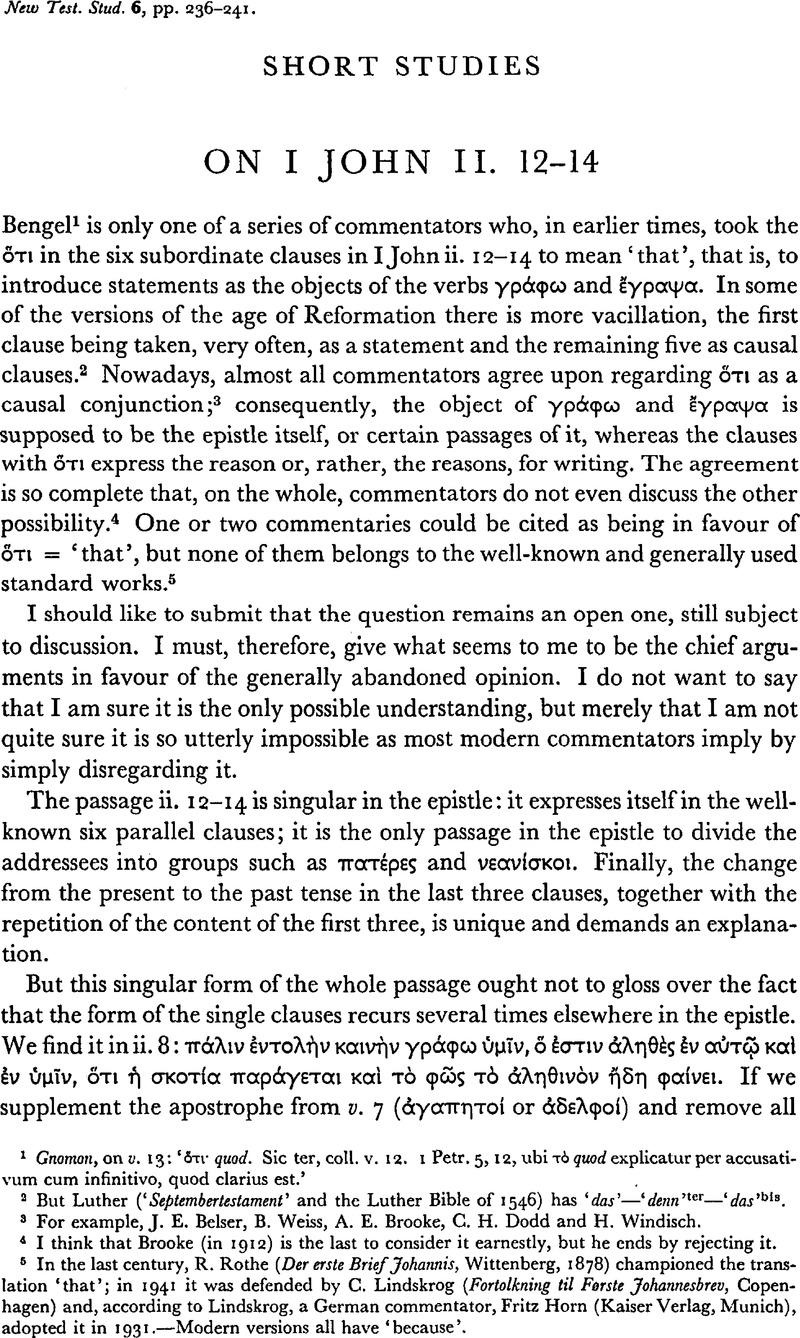Article contents
Abstract

- Type
- Short studies
- Information
- Copyright
- Copyright © Cambridge University Press 1960
References
1 Gnomon, on v. 13: ‘δτı quod. Sic ter, coll. v. 12. 1 Petr. 5, 12, ubi τó quod explicatur per accusativum cum infinitivo, quod clarius est.’
2 But Luther (‘Septembertestament’ and the Luther Bible of 1546) has ‘das’—‘denn’ter—‘das’bis.
3 For example, J. E. Belser, B. Weiss, A. E. Brooke, C. H. Dodd and H. Windisch.
4 I think that Brooke (in 1912) is the last to consider it earnestly, but he ends by rejecting it.
5 In the last century, Rothe, R. (Der erste Brief Johannis, Wittenberg, 1878) championed the translation ‘that’; in 1941 it was defended by Lindskrog, C. (Fortolkning til Første Johannesbrev, Copenhagen) and, according to Lindskrog, a German commentator, Fritz Horn (Kaiser Verlag, Munich), adopted it in 1931.-Modern versions all have ‘because’.Google Scholar
1 In this way it recalls the use of έγραψα a in other concluding chapters, for example, II Cor. xiii. 10; Gal. vi. II; Philem. vv. 19, 21; cf. also John xx. 30–1 and Rev. xxii. 18–19.
2 Or, the other way round, our clauses could be transcribed after the manner of v. 13: γράϕω úμίν τεκνια,ίνα ειδ̃ητε òτι άμαρτιαı δıά τóδνυμα αúτυú.
1 γράϕω δτı in the sense of ‘I write that’ is not infrequent; there are all the instances of γέγραπταı c. δτı recitativo, which are only special cases of ‘declarative’ δτı and presuppose the latter. As for γράϕω with declarative δτı, see Liddell-Scott-Jones, Lexicon, s.v. γράϕω II (referring to Thuc. 7. 14, έπıσταμένοıς δ' úμίν γράϕω δτı βραχεία άκμή πληρώματος). As for δτı = ‘that’ in papyri, see Moulton and Milligan, The Vocabulary of the New Testament, s.v. δτı (inst. omn.: αίγραψά σοı, δτı γυμνóς ειμεı).
2 In v. 9 we have δτı both as a causal and as an objective conjunction (cf. Robinson, A. T., A Grammar of the Greek New Testament, 3rd ed., p. 964).Google Scholar For a full discussion, see Abbott, E. A., Johannine Grammar, pp. 154–61.Google Scholar
3 Brooke takes the opposite view: ‘Usage is probably in favour of the “causal” meaning. There is no certain [italics mine] instance in the Epistle of the use of δτı after γράϕω in the “declarative” sense.’
4 The view of Westcott, ‘St John does not write to make known the privileges of Christians, but to enforce the duties which follow from them’, cannot be upheld as regards all parts of the epistle; on the contrary, it is characterized by intermittent dogmatic preaching and paraenetic appeal, cf. Bultmann, R., in In Memoriam Ernst Lohmeyer (1957), p. 191.Google Scholar
1 Weidinger, K., Die Haustafeln. Ein Stück urchristlicher Paränese. (Untersuchungen zum Neuen Testament, herausgeg. v. H. Windisch, Heft 14), Leipzig, 1928, p. 73: ‘Für die Bekanntschaft des johanneischen Kreises mit unserem Schema (viz. “Haustafel”) sprechen die Verse I Joh. 2, 12–14.’Google Scholar
- 1
- Cited by




